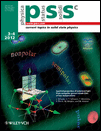Optical studies of quantum dot-like emission from localisation centres in InGaN/GaN nanorod array LEDs
Abstract
Microphotoluminescence with one-photon and two-photon excitation has been employed to investigate localisation centres found in nanorod array LEDs. Quantum dot-like features with spectral width less than 1 meV were observed originating from low dimensional carrier confinement within the nanorods. Two-photon excitation was used to probe the individual localisation centres. The narrow peak PL energy does not shift with increasing excitation density, but rather an increase of discrete new peaks on the high energy side of the spectrum is observed. There is no temperature dependent emission energy shift observed from 4.3 K to 25 K. (© 2012 WILEY-VCH Verlag GmbH & Co. KGaA, Weinheim)




